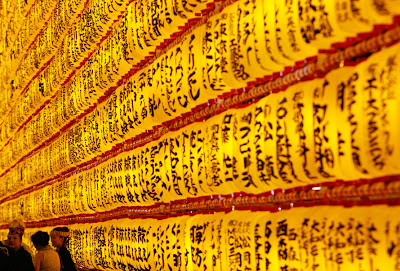(RoninDave) Obon is the Japanese Festival of the Dead. Japanese believe that the spirits of the departed return home briefly. Obon is a Buddhist festival adapted to the native Shinto tradition of the Mitama (spirit of the deceased) Festival associated with Obon.
Yasukuni Shinto Shrine celebrates the Mitama Festival in July like a traditional Obon celebration: Bon Odori (dancing) and Toro Nagashi (placing paper lanterns in water) with the difference that the Mikoshi (portable Shinto shrine) is marched swaying up to the shrine while chanting. Harmful spirits are driven away during Joma Shinji - Kyudo (Japanese Archery) New Year's Exorcism Ritual.
 Visitors walk past paper lanterns at the Yasukuni Shrine in Tokyo. More than 30,000 lanterns donated by citizens are displayed on the grounds during the four-day annual summer festival to comfort the souls of Japan's war dead (AP/Shizuo Kambayashi).
Visitors walk past paper lanterns at the Yasukuni Shrine in Tokyo. More than 30,000 lanterns donated by citizens are displayed on the grounds during the four-day annual summer festival to comfort the souls of Japan's war dead (AP/Shizuo Kambayashi). Visitors walk past paper lanterns during the Mitama (Soul) Festival at the Yasukuni Shrine in Tokyo on Wednesday, July 15, 2009.
Visitors walk past paper lanterns during the Mitama (Soul) Festival at the Yasukuni Shrine in Tokyo on Wednesday, July 15, 2009.More than 30,000 lanterns donated by citizens are displayed in the grounds during the four-day annual summer festival to give solace the souls [gandhabbas in the rarer sense and pretas, continuity of consciousness and ghosts of the departed] of Japan's war dead.
Most in the West have put Fukishima out of mind as danger worsens.
The self is a compounded process constantly in flux -- a stream of successive moments without identity, taken in ignorance (and much to one's disadvantage) as me, mine, myself.
This results in identification with what is not-self, not one's own, not under one's control.
- form (body, Four Great Elements, derived materiality)
- feelings (pleasant, unpleasant, and neutral sensations)
- perceptions (impressions of the six senses including mind)
- mental formations (represented by volitions or will)
- consciousness (reflexive awareness)
These are taken to be an enduring soul or self by assuming that they are permanent (lasting for more than a moment), satisfactory, and personal when they are the opposite.
They are radically impermanent and unreliable (arising and falling and immediately replaced by a similar but non-identical conscious-moments and particles, cittas and kalapas). They are disappointing and unsatisfactory (dukkha). And most amazingly, they are impersonal.
Some take this to be a nihilistic doctrine. It is, in fact, good news leading to liberation. For it is clinging to the illusion, struggling with reality to be other than it is, that gives rise to suffering.
For a brief but thorough explanation of this extraordinarily deep and important Buddhist teaching, see the dictionary entry ANATTA by Ven. Nyanatiloka (Buddhist Dictionary: Manual of Buddhist Terms and Doctrines).
- PHOTO 2: Representing a scary "hungry ghost" (preta) J.B. Letuli wears blue body paint design by DC Entertainment. She awaits her entrance during the 2009 UFO Festival Alien Costume Contest at Pearson Auditorium (AP/Roswell Daily Record/Mark Wilson). Roswell UFO Festival photos


































































































































































































































No comments:
Post a Comment